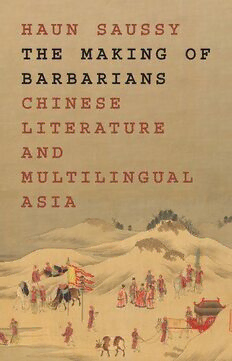
The Making of Barbarians: Chinese Literature and Multilingual Asia PDF
Preview The Making of Barbarians: Chinese Literature and Multilingual Asia
This content downloaded from 128.95.155.147 on Mon, 29 Aug 2022 15:41:08 UTC All use subject to https://about.jstor.org/terms the making of barbarians This content downloaded from 128.95.155.147 on Mon, 29 Aug 2022 15:41:08 UTC All use subject to https://about.jstor.org/terms SERIES EDITOR EMILY APTER A list of titles in the series appears at the back of the book. This content downloaded from 128.95.155.147 on Mon, 29 Aug 2022 15:41:08 UTC All use subject to https://about.jstor.org/terms The Making of Barbarians chinese lite ra t ure and multilingual asia haun saussy prince ton university press princet on & oxford This content downloaded from 128.95.155.147 on Mon, 29 Aug 2022 15:41:08 UTC All use subject to https://about.jstor.org/terms Copyright © 2022 by Prince ton University Press Prince ton University Press is committed to the protection of copyright and the intellectual property our authors entrust to us. Copyright promotes the pro gress and integrity of knowledge. Thank you for supporting free speech and the global exchange of ideas by purchasing an authorized edition of this book. If you wish to reproduce or distribute any part of it in any form, please obtain permission. Requests for permission to reproduce material from this work should be sent to permissions@press . princeton . edu Published by Prince ton University Press 41 William Street, Prince ton, New Jersey 08540 99 Banbury Road, Oxford OX2 6JX press . princeton . edu All Rights Reserved Library of Congress Control Number: 2021949467 ISBN 9780691231976 ISBN (e- book) 9780691231969 British Library Cataloging- in- Publication Data is available Editorial: Anne Savarese, James Collier Jacket Design: Karl Spurzem Production: Erin Suydam Publicity: Alyssa Sanford, Charlotte Coyne Copyeditor: Anita O’Brien Jacket art: Eighteen Songs of a Nomad Flute: The Story of Lady Wenji, unidentified artist, early 15th century, Ming Dynasty (1368–1644). Ex coll.: C.C. Wang Family, Gift of the Dillon Fund, 1973. This book is published with the generous support of Research Center for Chinese Cultural Subjectivity in Taiwan at National Chengchi University This book has been composed in Arno Printed on acid- free paper. ∞ Printed in the United States of Amer i ca 10 9 8 7 6 5 4 3 2 1 This content downloaded from 128.95.155.147 on Mon, 29 Aug 2022 15:41:08 UTC All use subject to https://about.jstor.org/terms Es ist niemals ein Dokument der Kultur, ohne zugleich ein solches der Barbarei zu sein. ( There is no document of civilization which is not at the same time a document of barbarism.) — walter benjamin, “ theses on the philosophy of history” the earth the sky the people around him the fruit the shops, it was all one and the same, all of it and him, and this kind of a feeling he always gave to them who saw him walking standing thinking talking, that the world was all him, there was no difference in it in him, and the fruit inside or outside him there were no separations of him or from him, and the whole world he lived in always lived inside him. —Gertrude Stein, The Making of Americans This content downloaded from 128.95.155.147 on Mon, 29 Aug 2022 15:41:08 UTC All use subject to https://about.jstor.org/terms This content downloaded from 128.95.155.147 on Mon, 29 Aug 2022 15:41:08 UTC All use subject to https://about.jstor.org/terms contents Introduction: Intrinsically Extrinsic 1 1 The Nine Relays: Translation in China 11 2 Can the Barbarians Sing? 33 3 The Hanzi wenhua quan: Center, Periphery, and the Shaggy Borderlands 58 4 The Formation of China: Asymmetries in the Writing of History 85 5 Exiles and Emissaries amid Their New Neighbors: The View from the Edge of the World 108 Conclusion: Frames, Edges, Escape Codes 134 Acknowl edgments 141 Notes 143 Index 175 vii This content downloaded from 135.181.184.204 on Mon, 29 Aug 2022 15:41:41 UTC All use subject to https://about.jstor.org/terms This content downloaded from 135.181.184.204 on Mon, 29 Aug 2022 15:41:41 UTC All use subject to https://about.jstor.org/terms Introduction Intrinsically Extrinsic 物无非彼,物无非是 as we learn in our first encounters with the Chinese language and civilization (for some, this event takes place practically at birth), the adjective that qualifies China in Chinese is Zhong 中, “center” or “inward”; what is not Chinese is wai 外, “outside.”1 “In” and “out” are what we call in En glish prepositions: they describe relations, not essences. Over the long course of Chinese civiliza- tion, some practices or values have often been singled out as the core or essence of Chineseness: the zhong of the Zhong, as it were. My many years of fascination with China have not led me in that direction. The inquiry conducted in this book goes relationally and indirectly, asking how the wai defines the zhong for one of those practices deemed to be closest to the civilization’s core: writ- ing, the effort to shape the world through and as a system of en- during traces. In other words, it is about the outside seen from the inside, as reconstructed by an outsider. My inquiry into the intrinsic, the extrinsic, and the literary has taken shape in the space between two quotations from the early Chinese empire. First we have the proud proclamation of sovereign centrality and commonality, achieved through the 1 This content downloaded from 135.181.184.204 on Mon, 29 Aug 2022 15:42:04 UTC All use subject to https://about.jstor.org/terms
